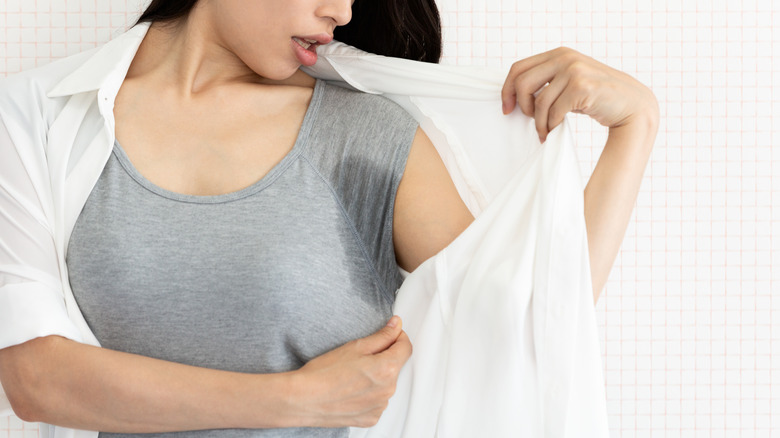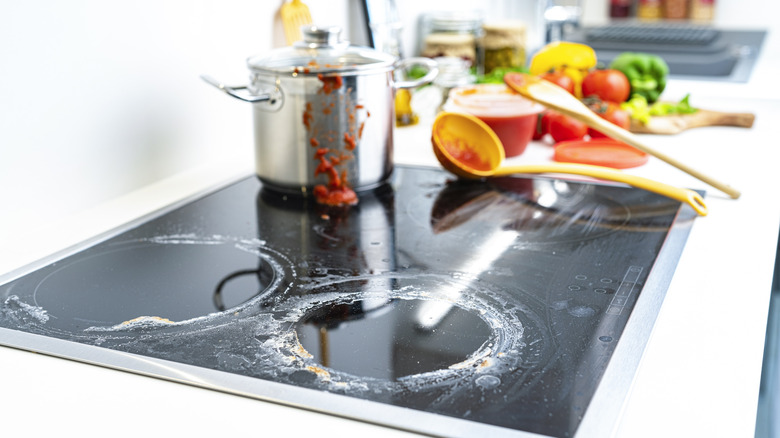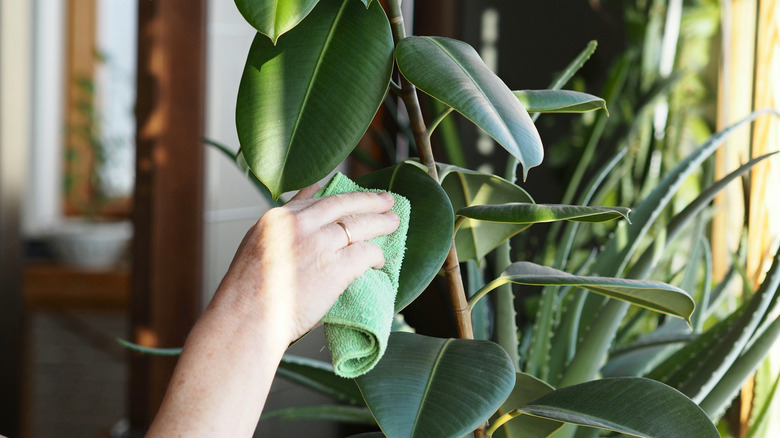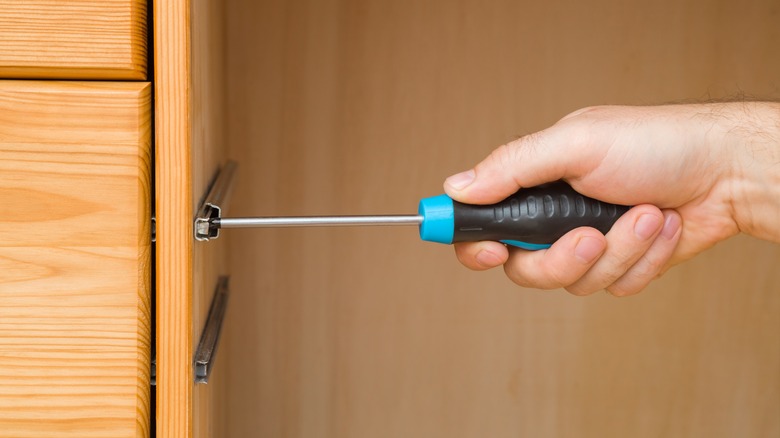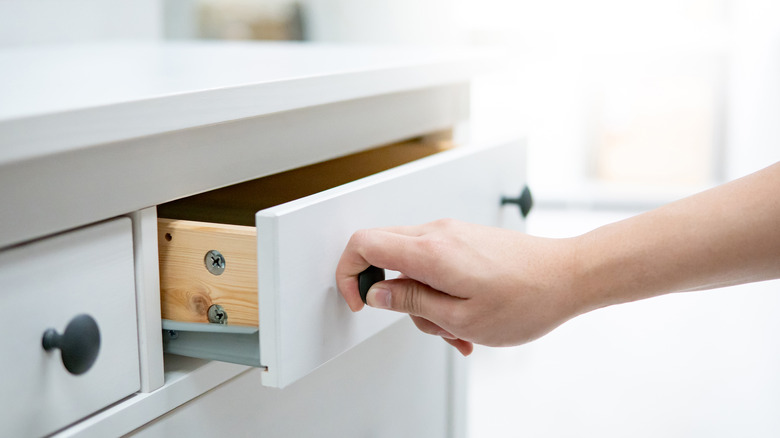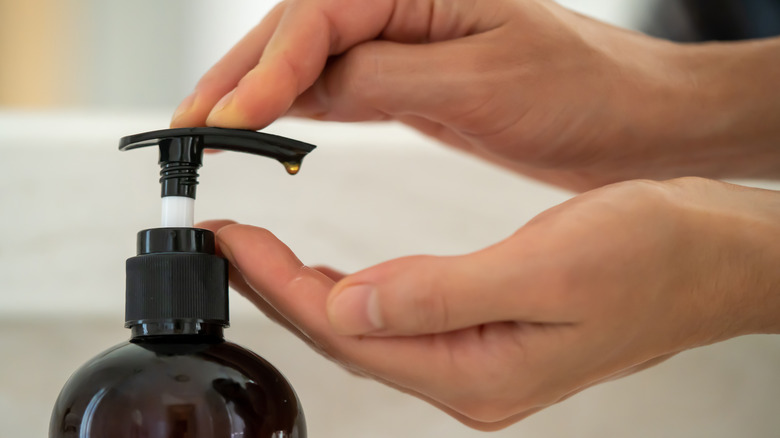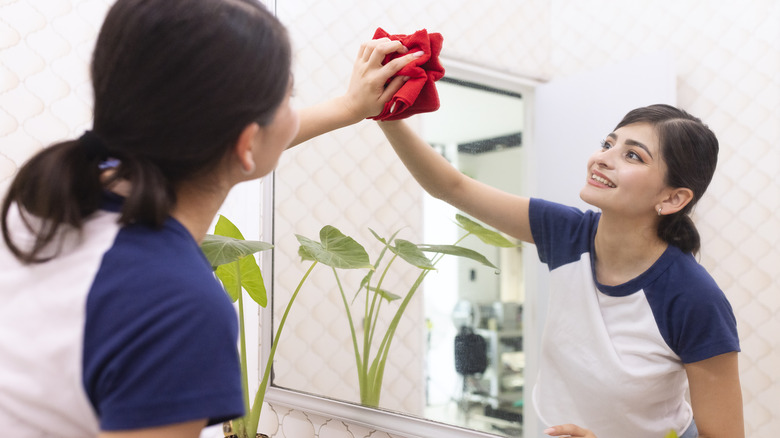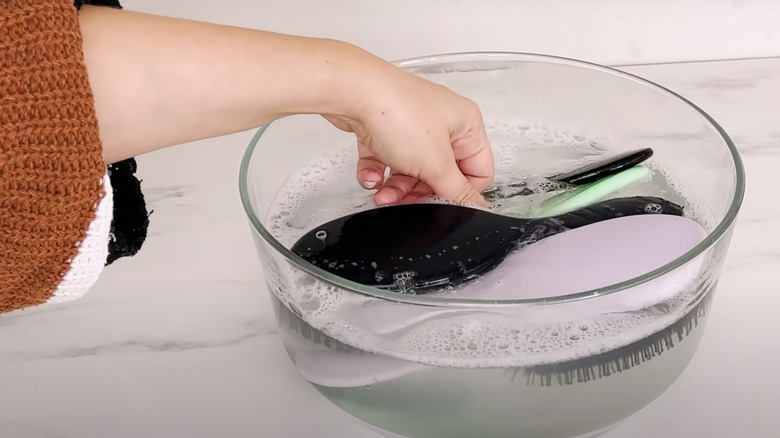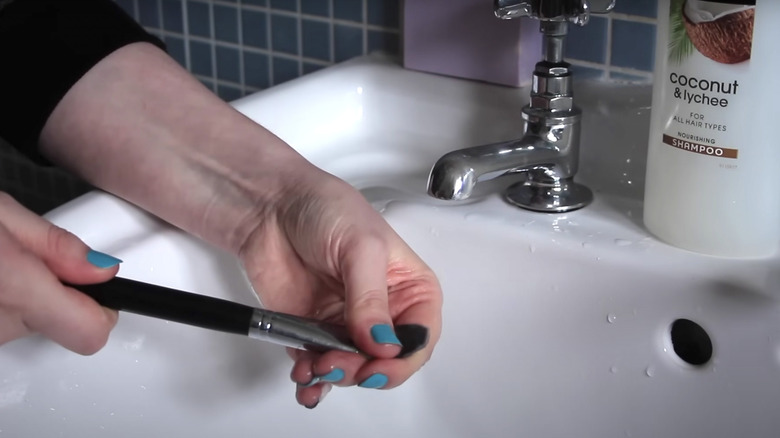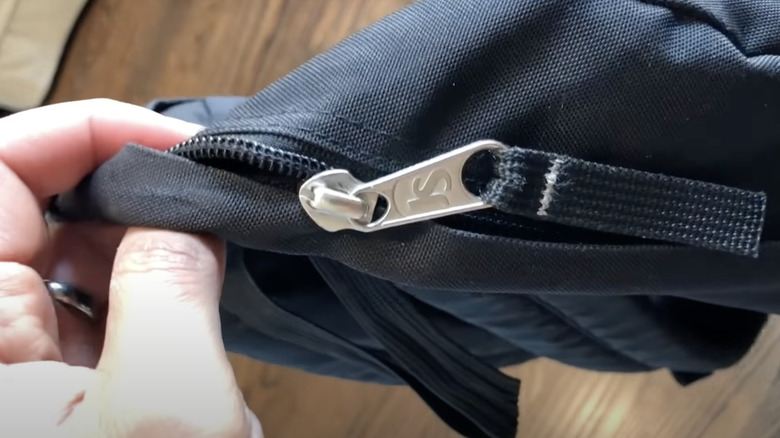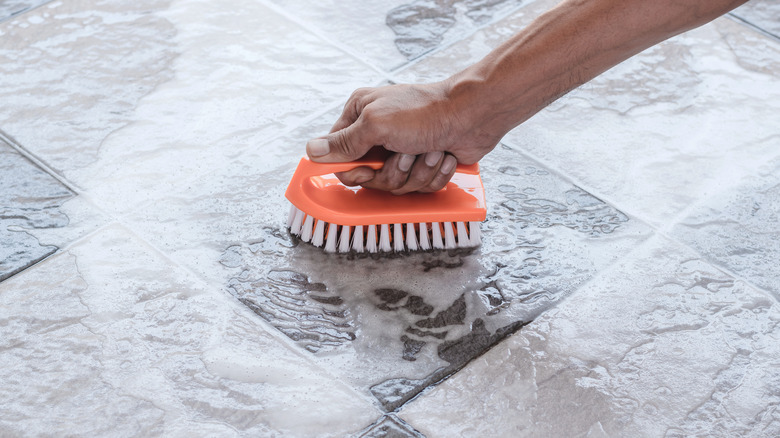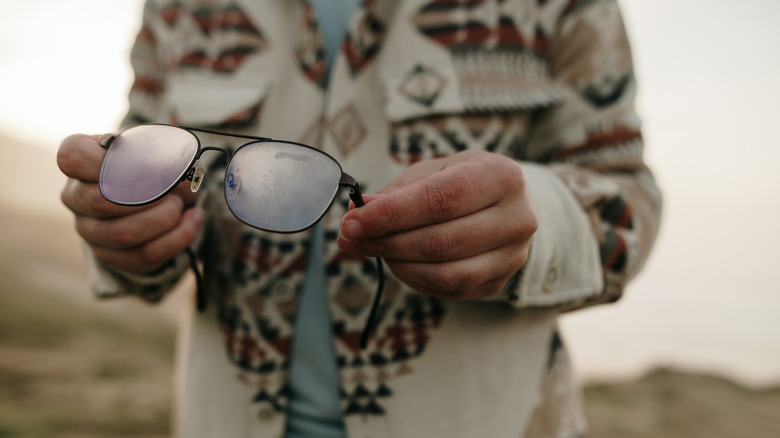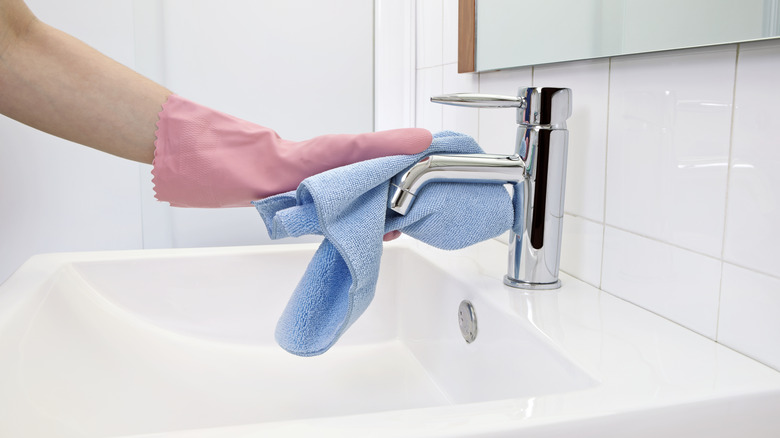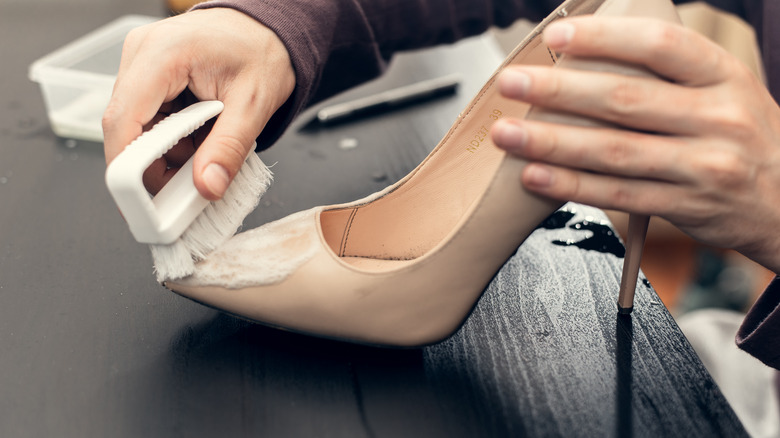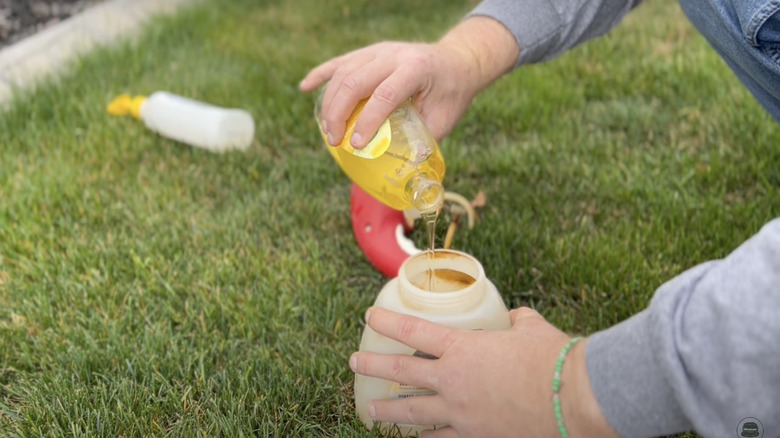Uncommon Uses For Shampoo Around The House
Shampoo is considered an essential in most households, and it's often found beside bathtubs, on shower shelves, or stored away in bathroom cabinets. Although this hair product is primarily designed to clean human hair and skin, its natural and gentle ingredients are also ideal for other household tasks. With a small dollop and some water, you can make a homemade solution for cleaning laundry, appliances, furniture, decorations, flooring, and even living plants.
There are hundreds of shampoo brands and types on the market, but for the most part, they contain a similar list of ingredients. Their formulas often include water, sulfates, silicones, sodium chloride, and other natural additives. Due to these ingredients' gentle and non-abrasive nature, they're usually safe to use on various materials. This is especially true for shampoos labeled as gentle, for babies, or for sensitive skin. Check out the list below for how this hair product can remove debris buildup, shine up materials, and perform basic cleaning inside and outside your home.
Treat sweat stains
Usually, laundry stains are blamed on ineffective detergents, malfunctioning washing machines, or rogue clothing items that end up in the wrong laundry pile. However, if you find discolored rings and spots on the underarms of your t-shirts, you're most likely dealing with a sweat stain. Don't let these marks leave your favorite shirts unwearable. Instead, use shampoo as a pre-treater to tackle them.
Softly pat baby shampoo onto the spots where these stains are most prominent. Give the formula at least half an hour to set into the stained clothing item before you throw it in your washing machine and run your usual cycle. When your clothes come out, the stains should be gone.
Before you start, just make sure you do a quick test in an inconspicuous spot. Let the baby shampoo set into the fabric and ensure its ingredients don't cause discoloration or bleaching. There shouldn't be any issues since baby products usually use gentle and non-abrasive ingredients.
Clean grease off stovetops
A kitchen is easily the messiest room in a household, and it's helpful to know all the hacks for wiping down busy stoves. While cooking, fats and oils can fizzle and pop, landing on the top of a stovetop. And, once the meal is finished and served, cleanup can be tricky, as the greasy residue has been hardened onto the surface.
Luckily, shampoo is built to remove excess hair oils and is just as useful for removing leftover food oils. Put a quarter-sized drop of shampoo on a water-soaked washcloth and begin buffing out the residue with circular motions. Lather up your stove until you leave a thin layer of bubbles and soap behind, and let it sit for a few minutes. Grab a new rag, soaked only with water, and easily wipe away the oils.
If it turns out to be a trickier job and the greasy buildup is more than you expected, sprinkle some baking soda to neutralize the acidic content in the grease. Since baking soda has a lower acidic level than most foods, it neutralizes the leftover particles. The neutralized residue then becomes easier to dislodge with the combination of shampoo and water.
Wipe dust off of houseplants
Since house plants are kept indoors, they don't often sport colorful flowers. Instead, they show off vibrant, waxy-textured leaves. When plants are healthy, their leaves add a gorgeous touch of lush green to your home, but they must be dusted to keep their aesthetic appearance.
Keep in mind that ensuring your plant is dust-free isn't only good for appearances. Too much dust can inhibit a plant's ability to absorb sunlight and perform photosynthesis. Since every plant owner knows that a lack of light is a death sentence, it's imperative that you remove the unsightly powdery layer that gathers on their leaves.
One of the methods for keeping your plant looking clean and crisp is by using shampoo to remove the natural dust buildup. Make sure your shampoo doesn't contain sodium, borax, chlorine, or petroleum distillates, which are unsafe for houseplants. Once you've confirmed that you have the right shampoo, put a few drops of the gentle formula in a bowl of water. Dip a paper towel or clean rag into the bowl and gently swipe the watery solution over the tops and bottoms of your leaves. It should wipe away the dust and leave very little residue behind, ensuring your plants continue to thrive.
Loosen nuts and bolts in furniture and walls
When you need to disassemble furniture or take down decorations, nothing is more frustrating than not being able to unscrew nuts, bolts, and other fasteners. Months or years in a stationary position can cause items to rust or clog with dust and dirt. This debris jams the tiny ridges in fasteners, making them nearly impossible to function.
Seeing as shampoo contains ingredients that break up dirt, it's the natural solution to help dislodge the residue anchoring your fasteners. Squeeze a small amount over the stuck nuts and bolts, being careful not to expel too much. When the fastener is sufficiently oiled up, you should have an easier time unscrewing it using the appropriate tool.
Just keep in mind that you should use a minimal amount of shampoo for this method, especially when working around fixtures made of unfinished wood. Porous materials easily absorb the oils from shampoo and the creamy formula can't be reversed. If you aren't careful, your furniture or decorative objects can have permanent distortion or bloat that cannot be undone.
Silence squeaky hinges and faucets
Typically, the older a house and its contents are, the more likely fixtures, appliances, doors, and windows are to squeak when moved. Everything, from the rotating bar stools to the kitchen faucet, may let out an unpleasant squeal when turned. Luckily, there's a way to muffle this ear-piercing sound.
The first step is to seek out where a sound is coming from. Rotate, push, or pull the object making an offensive sound to determine which hardware piece or hinge is causing it. Once you know which part is the culprit, simply squeeze out a dollop of shampoo and wipe it over the metal offender. You can use your finger, or if you want to avoid accidentally pinching yourself, a Q-tip also makes a great tool. Wipe away any excess soap with a paper towel or rag to keep it from dripping, and you should be all set.
Test the object after applying the shampoo by moving it. If it continues to squeak, you may need to apply more. Otherwise, you can store your favorite shampoo back in your bathroom until the current coat wears away and needs to be reapplied.
Use as dual-purpose hand soap
Both shampoo and liquid hand soap are considered hygienic essentials in households, though they are used for different purposes. Despite the alternative intents, these two products share many common ingredients. Both contain sodium laureth sulfate, sodium lauryl sulfate, and cocamidopropyl betaine, which are substances that help dislodge dirt from skin and hair. They also contain benzyl alcohol, essential oils, and artificial fragrances, which are the ingredients responsible for the pleasant scent of these products.
Given their track record of similar ingredients, it's unsurprising that you can substitute shampoo for standard hand soap. The surfactants in shampoo help remove dirt and sticky residue, while the added fragrances make your hands smell clean. Many shampoos also produce a lot of lather so a small amount is all you need. Of course, shampoo won't replace antibacterial soap so keep that in mind if you're trying to prevent germs from spreading.
Defog bathroom mirrors
There are few activities as therapeutic as taking a shower hot enough to cause steam to billow out around you. Even with a hard-working bathroom fan, enjoying a sauna-esque shower experience can leave your mirrors obscured in fog, rendering them useless. Luckily, you can keep the fog at bay using a temporary solution with a little shampoo and a paper towel.
Before you start the water for your next shower, put a dollop of shampoo on your mirror. Spread the soap across the entire glass piece or just across the portion you want to stay clear of condensation. Buff out the soapy streaks with another clean paper towel or soft cloth to prevent moisture from gathering. Keep in mind that you will have to repeat this often. Depending on how hot you like your showers, how powerful your bathroom fan is, and how long you take to wash up, you may have to reapply the shampoo several times a week.
Untangle hair out of dirty combs and hairbrushes
Whether your hair is long or short, curly or straight, you should be washing your hairbrushes on a weekly to monthly basis. Over time, dried hair products, old skin and hair, lint, and dust gather in a tangled mess between the bristles. When you neglect cleaning this tool, you brush the random debris and bacteria through your hair every time you use it. The build-up can also cause the brush to not work as well as it should.
There are two ways to use shampoo to remove this dirt and keep your brushes in usable condition. The first method is to fill a large bowl or sink with warm water, add a few drops of shampoo, and stir until you have a soapy miniature bubble bath. Drop your hairbrush collection in the water for 10 to 15 minutes, jostle them around, and rub out the dirt and hairs by hand. If you have a wide-toothed comb, paintbrush, or spare toothbrush, you can use these tools to scrub and remove the most tangled bits.
The alternate strategy is just as easy. Apply a drop of shampoo directly to your brush and use your finger to scrub it clean while running it under a constant stream of hot water. This method is more effective if your brushes need more one-on-one care or if you only need to clean one or two. Whichever cleaning strategy you choose, make sure you lay out your brushes to dry with the bristle side down so the water can fully drain before you put them away.
Remove makeup residue from makeup brushes
Makeup brushes come in various styles, shapes, and sizes, and it's important that you clean these even more often than you clean your hairbrush. Uncleaned makeup brushes quickly become clogged with leftover makeup, dirt, oil, and skin cells making them vulnerable to grime buildup and bacteria. To keep them well-maintained, you should wash your brushes every seven to ten days. Otherwise, they could cause acne or surface rashes on your skin, sloppy makeup application, and, most importantly, dangerous infections.
Scrubbing these brushes requires many of the same steps it takes to clean a standard hairbrush. You can either wash them in a bowl or filled sink, or run each brush individually under hot running water. If your skin isn't sensitive, use a clarifying shampoo that contains surfactants and sulfates that are effective at breaking down oily buildup. However, if you have sensitive skin, lean towards gentle or baby shampoos that don't contain sulfates. Either way, be sure to thoroughly rinse your makeup brushes after washing them.
Remove buildup causing a sticky zipper
Zippers are known for being more convenient than traditional buttons and snap fasteners. They are used to close everything from jackets to suitcases and purses. Over years of use, dirt, dust, and other grime slowly builds up in the slider part of the zipper, making it difficult to maneuver up and down. All it takes is a little lubricant to unstick the sliding piece from the teeth, which are the pointed pieces that make up the zipper's path.
Carefully dip a Q-tip into any shampoo bottle, and dab the swabbed end to your zipper. The soapy mixture should help break up debris so you can move the fastener both ways once more. Since you're using a Q-tip and a miniscule amount of shampoo, there shouldn't be much cleanup afterward. If any residual shampoo gets on the surrounding fabric, make sure to rinse your zipped item thoroughly and hang it up to dry.
Shine up tile and ceramic floors
The beauty of tile and ceramic floors is that they don't require much cleaning, and when they do, you can use many different products to complete the task. The ingredients in shampoo are gentle enough for human skin and hair but strong enough to dislodge grease and oils. This makes them ideal for mopping tile and ceramic flooring. Plus, you only need a tiny bit to get the job done.
Before you begin, vacuum or sweep to pick up loose dirt and debris. Mix one or two teaspoons of shampoo in a bucket of hot water and swirl it until it's well mixed. Use a combination of water and shampoo to clean your floors over the entire area. A soft brush or microfiber mops can be used if you need extra cleaning power. Then, use clean hot water and a separate mop or scrubber to wipe away residual soap. Your floors should gleam with the same shine you would get from using most other household cleansers or soaps.
Stop eyewear from fogging up
When warm air gets trapped behind transparent glass or plastic, it results in condensation that fogs and obscures visibility. This isn't just a problem for people wearing eyeglasses, as it also occurs with sunglasses, swimming masks, and goggles. The best way to keep these from fogging is by altering their surface tension. Don't let the scientific term scare you away — the fix is quite easy.
Use a shampoo that has a soft composition, without any beads or exfoliating properties. You can test your shampoo by pouring a little on your finger. If there is any roughness to its texture, you shouldn't rub it into your glasses or mask. The small beads can scratch and damage the transparent material, leaving permanent scuffs that mar your vision even more.
Use a gentle or baby shampoo and lightly rub it around the inside side of the glass or plastic. Gently but thoroughly rub it in using a soft microfiber cloth. The layer of soap should prevent fog from forming in the future. You will need to reapply when the coating wears off, but it only takes a few minutes and a tiny amount of an already-owned product to do so.
Revive and shine fixtures
Seeing as most people use shampoo to wash their hair in showers, bathtubs, and even sinks, it shouldn't be surprising that this cleanser is also safe to use around and on these products. The next time your bathtub, shower, sink bowl, and faucet fixtures need touching up, you don't have to go out and buy a specialty product. Instead, you can reach for the shampoo bottle you likely already have on hand.
You can generally use most shampoos for cleaning the inside of your tub or shower. However, when it comes to chrome finishes on faucets and handles, make sure you choose a shampoo with a neutral PH so the acidity doesn't damage the surface. Once you have the neutral shampoo in hand, squirt out a small amount and rub it into the material you intend to shine up. Rinse off the excess residue, and the surface should be polished and clean.
Buff and shine shoes
Anyone with a nice pair of shoes knows it takes work to keep them looking polished and new long-term. Leather shoes, in particular, need routine moisturizing to keep them from aging, cracking, and discoloring. The next time you need to buff out a few scuffs in your shoes or simply want to shine up, reach for some baby shampoo to get the job done.
Many baby shampoos contain gentle ingredients, like aloe vera and chamomile extract, which are safe enough for the delicate skin of infants. So, you can assume that if your shampoo is safe enough for babies, it's likely safe to apply to genuine leather and other high-grade shoe materials. The one ingredient you should watch for is alcohol, which dehydrates and can cause soft materials to crack.
Before you begin, it's always smart to do a spot test, applying a little shampoo to an inconspicuous area before you polish the entire shoe. If you wipe off the test area and don't see any discoloration, you're good to go. Apply the shampoo to the surface of the shoe, slowly rubbing a soft cloth in circular motions until the soap is no longer visible. It should remove odors, moisturize the leather or similar material, and erase stains. Don't use a rough washcloth or paper towel, for these materials have rough surfaces that can permanently scuff your footwear.
Fix hydrophobic soil
When you mix baby shampoo and water, you get a solution of natural ingredients that breaks surface tension and moisturizes wherever it's applied. It can also improve water absorption in lawns. The surfactants in the shampoo break down tougher soils, like clay and loamy mixtures, making it easier for water to penetrate the surface and reach the roots.
Since a coat of baby shampoo disrupts surface tension, it also works as an insect repellent. Many insects, like aphids and mealybugs, need surface tension to cling to the underside of grass. The coating of baby shampoo prevents them from gripping and feeding on the leaves, and they may just pass up on your lawn for one that's more inviting.
Applying baby shampoo to your lawn is a bit more complicated than most of these tips. You'll need to find one without any potentially harmful additives, and a pH level between 6.5 and 7, around the same as your lawn soil. Also, ensure the formula has no added dyes or fragrances that can damage grass. Once you find the right one, add about three ounces to a garden sprayer, fill it with water, and spray your lawn. You may need to add more soap and water depending on the size of your lawn. Three ounces and a gallon of water should be sufficient for about 1,000 square feet of grass.

